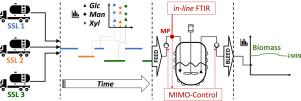Addressing raw material variation: Maintaining a steady-state during cultivation by blending of lignocellulosic feed streams
IF 3.7
3区 生物学
Q2 BIOTECHNOLOGY & APPLIED MICROBIOLOGY
引用次数: 0
Abstract
The transition to a sustainable bioeconomy necessitates the utilization of second-generation renewable resources. However, the inherent variability in the composition of these resources poses a challenge for establishing stable continuous bioprocesses. Industrial side-streams, such as spent sulfite liquor (SSL) from the pulp and paper industry, offer a promising starting point. Unlike first-generation processes, which rely on constant feed compositions, addressing the uncertainties of renewable resources requires robust monitoring and control strategies. To tackle the nonlinear dynamics of microbial conversion, we propose a model-based controller employing feedback linearization of a nonlinear model. Specifically, this study is focused on the uptake and bioconversion of sugars within SSL by Corynebacterium glutamicum. The controller dynamically adjusts mass flows into and out of the bioreactor to maintain steady-state conditions despite fluctuations in feed composition. Additionally, wood hydrolysate, rich in glucose and also from the paper and pulp industry, supplements the feed, enhancing control capabilities. Simulation studies showed that by actively controlling the process and adjusting the feed, harvest and bleed rates based on the sugar concentrations in the feed, process variability can be significantly reduced while sugar utilization increases. Experimentally, the introduced process was verified by continuous cultivation, whereby the process was effectively controlled and kept stable for more than 120 h with residual sugar concentrations always below 3.2 g/L. The decoupling of the multiple-input multiple-output system enables simultaneous and independent control of various process variables, establishing continuous cultivation processes resilient to raw material uncertainties and fluctuations.

解决原料变化:通过混合木质纤维素饲料流在培养过程中保持稳定状态
向可持续生物经济的过渡需要利用第二代可再生资源。然而,这些资源组成的内在可变性对建立稳定的连续生物过程提出了挑战。工业侧流,如纸浆和造纸工业的废亚硫酸盐液(SSL),提供了一个有希望的起点。与依赖于恒定饲料组成的第一代工艺不同,解决可再生资源的不确定性需要强大的监测和控制策略。为了解决微生物转换的非线性动力学问题,我们提出了一种基于模型的控制器,采用非线性模型的反馈线性化。具体来说,本研究的重点是谷氨酸棒状杆菌对SSL中糖的摄取和生物转化。控制器动态调节进出生物反应器的质量流,以保持稳态条件,尽管进料成分波动。此外,来自造纸和纸浆工业的富含葡萄糖的木材水解物补充了饲料,增强了控制能力。仿真研究表明,通过主动控制工艺,根据饲料中的糖浓度调整进料、收获和放血速率,可以显著降低工艺变异性,同时提高糖的利用率。实验中,通过连续培养验证了所引入的工艺,该工艺得到了有效的控制,并保持稳定120 h以上,残糖浓度始终低于3.2 g/L。多输入多输出系统的解耦使各种过程变量能够同时独立控制,建立对原材料不确定性和波动具有弹性的连续培养过程。
本文章由计算机程序翻译,如有差异,请以英文原文为准。
求助全文
约1分钟内获得全文
求助全文
来源期刊

Biochemical Engineering Journal
工程技术-工程:化工
CiteScore
7.10
自引率
5.10%
发文量
380
审稿时长
34 days
期刊介绍:
The Biochemical Engineering Journal aims to promote progress in the crucial chemical engineering aspects of the development of biological processes associated with everything from raw materials preparation to product recovery relevant to industries as diverse as medical/healthcare, industrial biotechnology, and environmental biotechnology.
The Journal welcomes full length original research papers, short communications, and review papers* in the following research fields:
Biocatalysis (enzyme or microbial) and biotransformations, including immobilized biocatalyst preparation and kinetics
Biosensors and Biodevices including biofabrication and novel fuel cell development
Bioseparations including scale-up and protein refolding/renaturation
Environmental Bioengineering including bioconversion, bioremediation, and microbial fuel cells
Bioreactor Systems including characterization, optimization and scale-up
Bioresources and Biorefinery Engineering including biomass conversion, biofuels, bioenergy, and optimization
Industrial Biotechnology including specialty chemicals, platform chemicals and neutraceuticals
Biomaterials and Tissue Engineering including bioartificial organs, cell encapsulation, and controlled release
Cell Culture Engineering (plant, animal or insect cells) including viral vectors, monoclonal antibodies, recombinant proteins, vaccines, and secondary metabolites
Cell Therapies and Stem Cells including pluripotent, mesenchymal and hematopoietic stem cells; immunotherapies; tissue-specific differentiation; and cryopreservation
Metabolic Engineering, Systems and Synthetic Biology including OMICS, bioinformatics, in silico biology, and metabolic flux analysis
Protein Engineering including enzyme engineering and directed evolution.
 求助内容:
求助内容: 应助结果提醒方式:
应助结果提醒方式:


